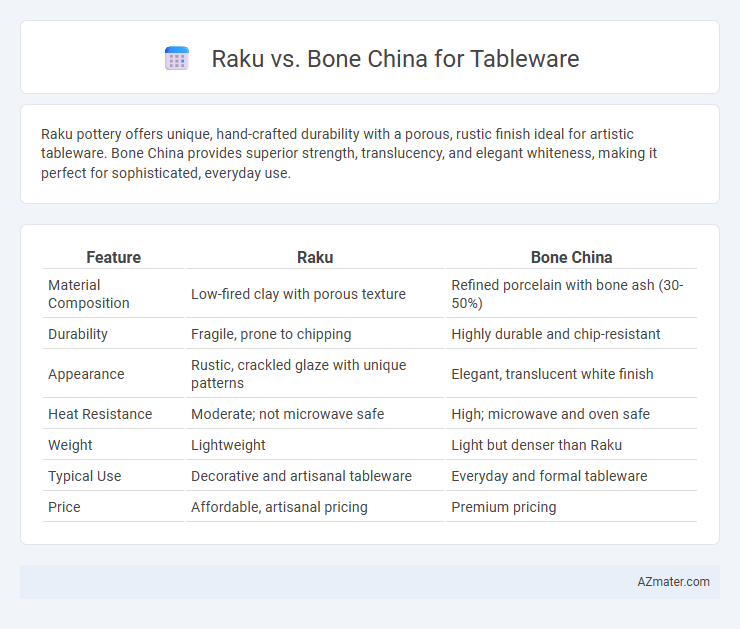Raku pottery offers unique, hand-crafted durability with a porous, rustic finish ideal for artistic tableware. Bone China provides superior strength, translucency, and elegant whiteness, making it perfect for sophisticated, everyday use.
Table of Comparison
| Feature | Raku | Bone China |
|---|---|---|
| Material Composition | Low-fired clay with porous texture | Refined porcelain with bone ash (30-50%) |
| Durability | Fragile, prone to chipping | Highly durable and chip-resistant |
| Appearance | Rustic, crackled glaze with unique patterns | Elegant, translucent white finish |
| Heat Resistance | Moderate; not microwave safe | High; microwave and oven safe |
| Weight | Lightweight | Light but denser than Raku |
| Typical Use | Decorative and artisanal tableware | Everyday and formal tableware |
| Price | Affordable, artisanal pricing | Premium pricing |
Introduction to Raku and Bone China
Raku is a traditional Japanese pottery technique characterized by low-firing temperatures and rapid cooling, resulting in unique crackled glazes and an organic, rustic aesthetic. Bone china, originating in 18th-century England, is a highly refined porcelain made from bone ash, feldspar, and kaolin, known for its whiteness, translucency, and exceptional strength. Both materials offer distinct qualities: Raku emphasizes artisanal texture and visual unpredictability, while bone china delivers delicate elegance and durability for fine tableware.
Historical Background of Raku and Bone China
Raku pottery originated in 16th-century Japan as a hand-crafted ceramic technique used in traditional tea ceremonies, emphasizing simplicity, natural textures, and rapid cooling methods. Bone China was developed in 18th-century England, combining porcelain clay with bone ash to create a durable, translucent, and elegant tableware highly prized in European aristocracy. Both materials reflect distinct cultural heritages, with Raku symbolizing Japanese wabi-sabi aesthetics and Bone China representing British innovation in fine porcelain manufacturing.
Material Composition and Production Techniques
Raku tableware is crafted using low-fired, porous clay and subjected to rapid cooling in open air or combustible materials, resulting in unique crackled textures and a handmade aesthetic. Bone china combines refined bone ash, kaolin, and feldspathic materials fired at high temperatures, yielding a durable, translucent, and non-porous surface ideal for fine dining. The contrasting production techniques--Raku's rapid cooling versus bone china's high-temperature firing--directly influence their material properties, with Raku emphasizing artisanal qualities and bone china prioritizing strength and elegance.
Visual Appearance and Aesthetic Qualities
Raku tableware features a unique handmade appearance with crackled glazes and earthy tones, offering an organic, rustic aesthetic that highlights natural imperfections. Bone china is celebrated for its translucent whiteness, smooth surface, and refined elegance, often decorated with intricate patterns and a glossy finish. The visual contrast between Raku's raw, textured appeal and bone china's polished sophistication makes each suitable for distinct dining atmospheres and aesthetic preferences.
Durability and Strength Comparison
Raku tableware, made through rapid cooling of ceramic, tends to be more porous and less durable compared to bone china, which boasts exceptional strength due to its high bone ash content and vitrified composition. Bone china excels in resistance to chipping and cracking, maintaining structural integrity under frequent use. The inherent toughness of bone china makes it a preferred choice for daily tableware, while Raku is better suited for decorative purposes due to its delicate nature.
Heat and Thermal Shock Resistance
Raku pottery, known for its unique firing process, exhibits moderate heat resistance but is highly susceptible to thermal shock due to rapid cooling, making it less suitable for sudden temperature changes. Bone china offers superior heat resistance and excellent thermal shock durability, attributable to its vitrified, dense structure enhanced by bone ash. For tableware requiring frequent use with hot foods and liquids, bone china provides a more reliable performance in preventing cracks and breakage.
Safety and Food Compatibility
Raku pottery, often handmade and fired at lower temperatures, may have porous surfaces that can harbor bacteria, making it less ideal for direct food contact without proper sealing. Bone china is vitreous and non-porous, offering superior safety and food compatibility due to its high firing temperature and smooth, glazed finish that resists absorption of liquids and contaminants. For daily use, bone china ensures hygiene and durability, while raku should be used with caution or as decorative tableware to avoid potential health risks.
Cost and Accessibility
Raku tableware tends to be more affordable due to its handmade nature and lower production costs, making it accessible to collectors and casual users seeking unique, artistic pieces. Bone china, being a high-quality porcelain with bone ash, commands higher prices but offers durability and a refined appearance favored in formal dining settings. Availability of raku is often limited to artisan studios or specialty shops, whereas bone china is widely accessible through major retailers and online stores globally.
Best Uses for Raku vs Bone China Tableware
Raku tableware is best suited for artistic, decorative, and casual dining experiences due to its unique, hand-crafted finish and occasional imperfections that enhance rustic charm. Bone china excels in formal dining settings, offering exceptional durability, translucent quality, and refined elegance ideal for special occasions and upscale restaurants. While Raku's porous nature makes it less suitable for frequent use or dishwasher cleaning, bone china withstands daily use and is dishwasher and microwave safe, making it practical for everyday luxury tableware.
Conclusion: Choosing the Right Tableware
Raku and Bone China offer distinct benefits for tableware, with Raku prized for its unique, handcrafted appearance and durability, perfect for rustic or artistic settings, while Bone China provides a sleek, translucent finish with exceptional strength and chip resistance, ideal for formal dining. Consider lifestyle and usage frequency: Bone China suits daily elegance and longevity, whereas Raku aligns with decorative or occasional use due to its artisanal nature. Selecting the right tableware hinges on balancing aesthetic preferences, durability needs, and the desired dining experience to ensure both functionality and style.

Infographic: Raku vs Bone China for Tableware
 azmater.com
azmater.com